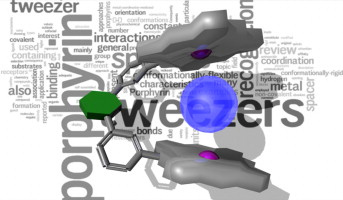Metallated porphyrins have been widely used as binding sites in covalently linked molecular tweezer receptors. This review describes selected examples of covalently linked porphyrin tweezer receptors extracted from the extensive literature generated in this area during the last 20 years. The binding processes of some porphyrin tweezer receptors with different substrates are discussed on the basis of the stoichiometry of the formed complexes, the magnitudes of their thermodynamic stabilities and the spectroscopic techniques used in the characterization. The physicochemical properties of the porphyrin units allow the use of a wide variety of techniques to probe the interaction of the tweezer receptors with different guests. The relationship that exists between the magnitude of the binding constant of 1:1 complexes involving ditopically bound ligands and the conformational features of the spacers is assessed in detail. The different strengths of the non-covalent forces, mainly metal–ligand coordination bonds and π–π interactions, involved in the formation of the host–guest complexes of the tweezers are also discussed and some of the relevant applications of molecular tweezers are also presented. In particular, the use of several porphyrin tweezers in the assignment of absolute configuration of chiral organic compounds using exciton-coupling circular dichroism spectroscopy is described. Finally, porphyrin tweezer receptors prepared through self-assembly processes are introduced and their binding properties emphasized.
